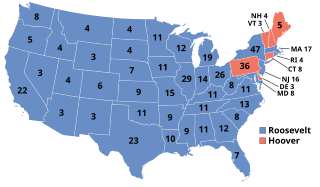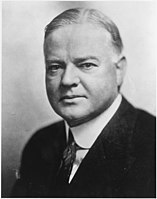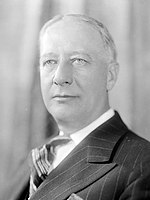
Presidential elections were held in the United States on November 6, 1928. Republican former Secretary of Commerce Herbert Hoover defeated the Democratic nominee, Governor Al Smith of New York. After President Calvin Coolidge declined to seek reelection, Hoover emerged as the Republican party's frontrunner. As Hoover's party opponents failed to unite around a candidate, Hoover received a large majority of the vote at the 1928 Republican National Convention. The strong state of the economy discouraged some Democrats from running, and Smith was nominated on the first ballot of the 1928 Democratic National Convention. Hoover and Smith had been widely known as potential presidential candidates long before the 1928 campaign, and both were generally regarded as outstanding leaders. Both were newcomers to the presidential race and presented in their person and record an appeal of unknown potency to the electorate. Both faced serious discontent within their respective parties' membership, and both lacked the wholehearted support of their parties' organization.

Presidential elections were held in the United States on November 8, 1932. Against the backdrop of the Great Depression, incumbent Republican President Herbert Hoover was defeated in a landslide by Democrat Franklin D. Roosevelt, the governor of New York and the vice presidential nominee of the 1920 presidential election. Roosevelt was the first Democrat in 80 years to simultaneously win an outright majority of the electoral college and popular vote, a feat last accomplished by Franklin Pierce in 1852, as well as the first Democrat in 56 years to win a majority of the popular vote, which was last achieved by Samuel J. Tilden in 1876. Roosevelt was the last sitting governor to be elected president until Bill Clinton in 1992. Hoover became the first incumbent president to lose an election to another term since William Howard Taft in 1912, the last to do so until Gerald Ford lost 44 years later, and the last elected incumbent president to do so until Jimmy Carter lost 48 years later. The election marked the effective end of the Fourth Party System, which had been dominated by Republicans. It was the first time since 1916 that a Democrat was elected president.

The 1992 United States presidential election in New York took place on November 3, 1992, as part of the 1992 United States presidential election. Voters chose 33 representatives, or electors to the Electoral College, who voted for president and vice president.

The 1976 United States presidential election in New York took place on November 2, 1976. All 50 states and the District of Columbia, were part of the 1976 United States presidential election. Voters chose 41 electors to the Electoral College, which voted for President and Vice President. New York was won by Democratic Georgia Governor Jimmy Carter, in a narrow victory against incumbent Republican President Gerald Ford, who failed to gain the presidency through formal election that year. Carter was running with Minnesota Senator Walter Mondale, and President Ford had selected Kansas Senator Bob Dole. The presidential election of 1976 was a very partisan election in New York, with more than 99% of the electorate voting for either Carter or Ford.

The 1972 United States presidential election in New York took place on November 7, 1972. All 50 states and the District of Columbia, were part of the 1972 United States presidential election. Voters chose 41 electors to the Electoral College, which voted for President and Vice President.

The 1936 United States presidential election in New York took place on November 3, 1936. All contemporary 48 states were part of the 1936 United States presidential election. Voters chose 47 electors to the Electoral College, which selected the president and vice president. New York was won by incumbent Democratic President Franklin D. Roosevelt of New York, who was running against Republican Governor of Kansas Alf Landon. Roosevelt ran with incumbent Vice President John Nance Garner of Texas, and Landon ran with newspaper publisher Frank Knox of Illinois.

The 1932 United States presidential election in New York took place on November 8, 1932. All contemporary 48 states were part of the 1932 United States presidential election. Voters chose 47 electors to the Electoral College, which selected the president and vice president.

The 1924 United States presidential election in New York took place on November 4, 1924. All contemporary 48 states were part of the 1924 United States presidential election. Voters chose 45 electors to the Electoral College, which selected the president and vice president.

The 1920 United States presidential election in New York took place on November 2, 1920. All contemporary 48 states were part of the 1920 United States presidential election. Voters chose 45 electors to the Electoral College, which selected the president and vice president.

The 1932 United States presidential election in Massachusetts took place on November 8, 1932, as part of the 1932 United States presidential election, which was held throughout all contemporary 48 states. Voters chose 17 representatives, or electors to the Electoral College, who voted for president and vice president.

The 1928 United States presidential election in Massachusetts took place on November 6, 1928, as part of the 1928 United States presidential election, which was held throughout all contemporary 48 states. Voters chose 18 representatives, or electors to the Electoral College, who voted for president and vice president.

The 1932 United States presidential election in Vermont took place on November 8, 1932, as part of the 1932 United States presidential election which was held throughout all contemporary 48 states. Voters chose three representatives, or electors to the Electoral College, who voted for president and vice president.

The 1928 United States presidential election in Vermont took place on November 6, 1928, as part of the 1928 United States presidential election which was held throughout all contemporary 48 states. Voters chose four representatives, or electors to the Electoral College, who voted for president and vice president.

The 1932 United States presidential election in New Jersey took place on November 8, 1932. All contemporary 48 states were part of the 1932 United States presidential election. Voters chose 16 electors to the Electoral College, which selected the president and vice president.

The 1928 United States presidential election in New Jersey took place on November 6, 1928. All contemporary 48 states were part of the 1928 United States presidential election. Voters chose 14 electors to the Electoral College, which selected the president and vice president.

The 1928 United States presidential election in Wyoming took place on November 6, 1928, as part of the 1928 United States presidential election. State voters chose three representatives, or electors, to the Electoral College, who voted for president and vice president.

The 1932 United States presidential election in Tennessee took place on November 8, 1932, as part of the 1932 United States presidential election. Tennessee voters chose 11 representatives, or electors, to the Electoral College, who voted for president and vice president.

The 1928 United States presidential election in Tennessee took place on November 6, 1928, as part of the 1928 United States presidential election. Tennessee voters chose 12 representatives, or electors, to the Electoral College, who voted for president and vice president.

The 1928 United States presidential election in Oklahoma took place on November 6, 1928, as part of the 1928 United States presidential election which was held throughout all contemporary 48 states. Voters chose ten representatives, or electors to the Electoral College, who voted for president and vice president. In its early years, Oklahoma was a “Solid South” state whose founding fathers like "Alfalfa Bill" Murray and Charles N. Haskell had disfranchised most of its black population via literacy tests and grandfather clauses, the latter of which would be declared unconstitutional in Guinn v. United States. In 1920 this “Solid South” state, nonetheless, joined the Republican landslide of Warren G. Harding, electing a GOP senator and five congressmen, but in 1922 the Democratic Party returned to their typical ascendancy as the state GOP became heatedly divided amongst themselves.

Republican candidate Herbert Hoover won the state of Illinois in the 1928 United States presidential election, and would emerge victorious from the overall election. State voters chose 29 representatives, or electors, to the Electoral College, who voted for president and vice president.




















